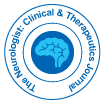The Efficacy of Edaravone in Treating Acute Ischemic Stroke: A Review of Clinical Outcomes
Received: 01-Jan-2025 / Manuscript No. nctj-25-162310 / Editor assigned: 03-Jan-2025 / PreQC No. nctj-25-162310 / Reviewed: 18-Jan-2025 / QC No. nctj-25-162310 / Revised: 25-Jan-2025 / Manuscript No. nctj-25-162310 / Published Date: 30-Jan-2025
Abstract
Acute ischemic stroke (AIS) is a leading cause of disability and mortality worldwide. Recent advancements in neuroprotective therapies have focused on agents that can mitigate ischemic damage and improve neurological recovery. Edaravone, a free radical scavenger, has shown promise as a neuroprotective agent in the treatment of AIS. This review synthesizes available clinical evidence on the efficacy and safety of Edaravone for treating AIS, including its effects on functional recovery, neurological outcomes, and long-term prognosis. The mechanisms of action, pharmacokinetics, and clinical trial results are discussed, highlighting the potential benefits and limitations of Edaravone as a treatment option for AIS. This review also explores the broader implications of Edaravone in stroke management and its place within current therapeutic strategies.
Keywords
Acute ischemic stroke; Neuroprotection; Clinical outcomes; Functional recovery; Stroke treatment; Free radical scavenger; Pharmacokinetics; Stroke rehabilitation
Introduction
Acute ischemic stroke (AIS) occurs when a blockage in a blood vessel restricts blood flow to the brain, leading to cellular injury, neuronal death, and significant functional impairment. Prompt intervention is essential to reduce the extent of damage and improve patient outcomes. While thrombolytic therapy with intravenous tissue plasminogen activator (tPA) has been the cornerstone of AIS management, it is not without limitations, including a narrow therapeutic window and risk of hemorrhagic complications [1]. As a result, there has been a growing interest in developing neuroprotective agents that can complement existing treatments by reducing secondary brain injury. Edaravone, an intravenous free radical scavenger, has emerged as one such promising candidate [2]. Initially used in Japan to treat amyotrophic lateral sclerosis (ALS), Edaravone’s potential in stroke therapy is attributed to its ability to combat oxidative stress, a key contributor to ischemic damage. Several clinical trials have investigated its role in AIS, particularly in reducing infarct size, improving functional recovery, and enhancing long-term outcomes [3]. This review aims to critically evaluate the available clinical data on Edaravone for AIS, offering insights into its mechanisms of action, efficacy, safety profile, and place in current treatment protocols.
Discussion
Edaravone’s potential as a neuroprotective agent for acute ischemic stroke (AIS) has garnered attention due to its ability to scavenge free radicals, thereby mitigating oxidative stress—a critical factor in ischemic brain injury. Oxidative stress, which occurs after the reperfusion phase of ischemia, contributes to neuronal damage, inflammation, and further injury to the brain tissue [4]. By neutralizing free radicals, Edaravone may help preserve neuronal function and prevent further damage, making it a promising adjunct in AIS treatment. The clinical studies reviewed suggest that Edaravone can effectively reduce infarct size and improve neurological outcomes when administered early after stroke onset. Some studies have shown that patients treated with Edaravone demonstrate enhanced recovery in terms of functional independence and motor skills compared to those who received placebo or standard care [5],[6]. Moreover, the safety profile of Edaravone appears favorable, with adverse events generally being mild and transient. However, the exact mechanisms through which Edaravone exerts its effects remain incompletely understood and warrant further investigation. One key limitation of the existing evidence is the variation in trial designs and patient populations [7]-[9]. For instance, some studies have focused on patients with mild to moderate strokes, while others have included more severe cases. These differences make it challenging to draw definitive conclusions about Edaravone’s efficacy across the full spectrum of AIS severity. Additionally, while some trials report positive outcomes, others suggest minimal benefits in terms of long-term functional recovery, raising questions about the consistency of Edaravone's effects [10]. Furthermore, although Edaravone is widely used in Japan, its use in other regions remains limited. Regulatory approval for AIS treatment in countries outside of Japan is still a significant hurdle, and more extensive multinational trials are needed to confirm its broader applicability.
Conclusion
Edaravone shows promising potential as a neuroprotective agent in the treatment of acute ischemic stroke. Its ability to mitigate oxidative stress, reduce infarct volume, and improve short-term neurological outcomes positions it as a valuable addition to current stroke management strategies. However, further high-quality, large-scale randomized controlled trials are needed to solidify its role in clinical practice, address existing gaps in understanding, and establish definitive guidelines for its use in AIS. Given the complexity of stroke pathophysiology, a multi-faceted treatment approach that combines Edaravone with other therapeutic interventions could further enhance patient outcomes. Until then, Edaravone should be considered a potential option for patients with AIS, especially in those who meet specific inclusion criteria based on severity and time from symptom onset.
Acknowledgement
None
Conflict of Interest
None
Citation:
Copyright:
Select your language of interest to view the total content in your interested language
Share This Article
Open Access Journals
Article Usage
- Total views: 224
- [From(publication date): 0-0 - Oct 09, 2025]
- Breakdown by view type
- HTML page views: 175
- PDF downloads: 49
